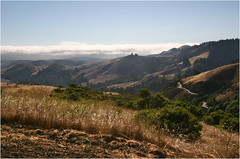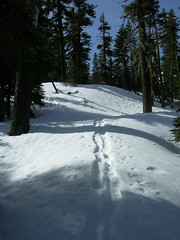My Douglas irises bloomed on my birthday, this year. I have a spring birthday; the irises around here often bloom near my birthday. I have a massive clump near my back steps, I bought a small specimen at the California Native Plant Society sale in 2001. It got a little big, then we moved, and I brought it with me. I thought it would die, it looked so battered when I put it into the ground at our new place.
This is our third spring here, and it's just huge, forty or so flowers on it. Next time we move, I'll divide it and share a little with friends . . . but bring its heart with me.
Douglas irises are special; they’re a wild iris that blooms on the Pacific coast of central California. They tend to be purple/blue, but can be white, or somewhat mauve. Of all the central California wildflowers, they are the flower I most eagerly anticipate every spring. I adore blue-eyed grass. California poppies fill my world with delight. But for some reason, it’s the irises I
look for, those are the flowers that mean, “Ah, spring.” Maybe it’s because the poppies start blooming in March, before my birthday. Maybe I love that they grow in long-lived clonal masses. I don’t know.
A huge percentage of organisms in California are endemic, they grow natively only here.
Thirty percent of plants are endemic. The endemic critters and plants (like the Tiburon mariposa lily), and those (like California poppies) that grow mostly here, but also elsewhere (poppies grow as far north as the north shores of the Columbia in central Oregon and Washington) form a huge component of my sense of place.
I am a Californian. I am a fifth generation Californian. My great great grandparents came here from Tennessee, “around the horn in a sailing vessel,” in 1856. They started out in northern California, on the Sacramento River delta, but there was malaria and typhoid and cholera, so they moved north to Clear Lake, then south, to the east side of Tulare Lake, which also had typhoid, but they didn’t know that when they left. My grandfather moved back to northern California as a very young man, and that was that, we’ve been Northern Californians ever since.
My sense of place in California, as well as being about the Golden Gate and Yosemite and the delta, the topography, is also about the biology of the area, knowing that irises will bloom near my birthday, that the “bathtub ring” of oak grasslands and chaparral, will sit at a certain place in a certain way, that the hummingbirds will have certain summer ranges.
I think that over my lifetime, as the climate changes, the ecology of California farther south – San Luis Obispo County, Fresno County – will move north. Spring will dry up a little sooner, north-facing hills won't stay green as long.
I like central California, but Cambria is not Half Moon Bay. There are no Douglas irises in Cambria. Redwoods don’t grow that far south.
I know that it is almost always ecologically unsound to introduce plants and animals where they don’t belong. The English introduced the common sparrow to New York. Now, they’re all over North America, displacing bluebirds, and pooping on the tables of sidewalk cafes. Spanish explorers accidentally introduced wild oats and other non-native grasses to California in the manure of their horses. Now, California’s fire-resistant, drought-resistant native grasses only grow in isolated patches.
Historically, with climate change, organisms that weren’t at extremes – the coldest, the driest, the wettest – could often adapt. As California warmed and dried over the past few thousand years, many of the drought-unadapted, “Mesozoic” plant communities like big-leaf maple and California sycamore and California buckeyes became riverine plant communities, staying where it remained cooler and damper. Other areas dried out, the sclerophyllic plants did better. The range of the redwood shrank a little; it remained robust farther north than it had before. But it had a place to go. Except for the most extreme – alpine plants that can’t go farther up, arctic animals that can’t go farther north, can’t find someplace colder – animal and plant communities could shift. There was a place for them to go. Now, with human fragmentation of the environment by development, by freeways and agriculture and forest clear-cutting and housing – where will they go? How will they get there?
One reason California has so many endemic organisms is because this is an island ecology; to the north the Siskiyou mountains prevent migration, to the east the Cascades and Sierra, to the southeast, the Mojave and Sonora deserts are a formidable barrier. They evolved with a particular ecology, and it is, perhaps, natural that climate change will eliminate some species, shift others, change things forever. But humans hadn’t come in, yet, to make adaptation that much harder.
As my “place” shifts north, as the climate changes, I find myself wanting to bring my things along, the animals and plants and communities that help form my sense of place. I find myself wanting to plant Douglas iris north of its current range, to bring the Redwood farther into Oregon. I find myself wanting to buy 50 acres southeast of Portland, right on the edge of the valley and oak lines and below the Douglas fir habitat, and plant redwoods (which grow well with Douglas-fir), blue oak, valley oak, California sycamore, California buckeye, poppies, blue-eyed grass, clarkia, all the wild irises of California (though Oregon has its perfectly nice Pacific Coast iris, the tough-leaved iris), each in its proper habitat, and see how it goes. Every five years or so, I could do a planting, the plants that will fit will do so, none of those is so weedy as to be an issue, except perhaps for poppies, which are already in Oregon. It’s not so much that I want to extend the range of these organisms but to make sure they have a place to live when their ranges dry up.
I
know this is ecologically unsound; I think of it more as a wish, a way to protect the organisms that might be hurt by global warming by bringing them to a new place, the Pacific Northwest as an ark for California. Maybe there’s room in British Columbia for the wildflowers currently thriving on Mt. Rainier.
I wish there were room, somewhere, for the plants of the tundra, the narwhal, and the polar bear. There’s no place for them to go.
















